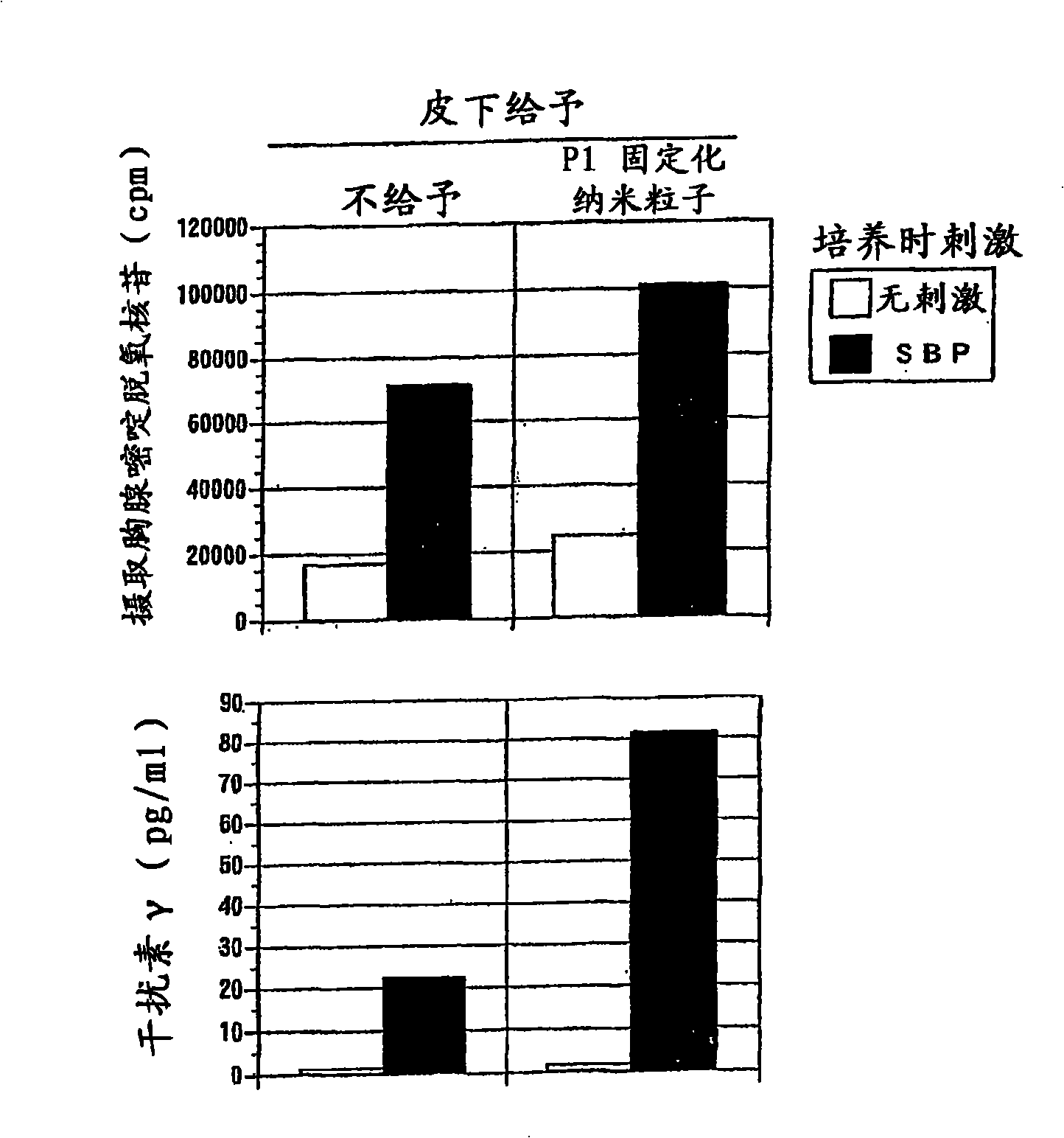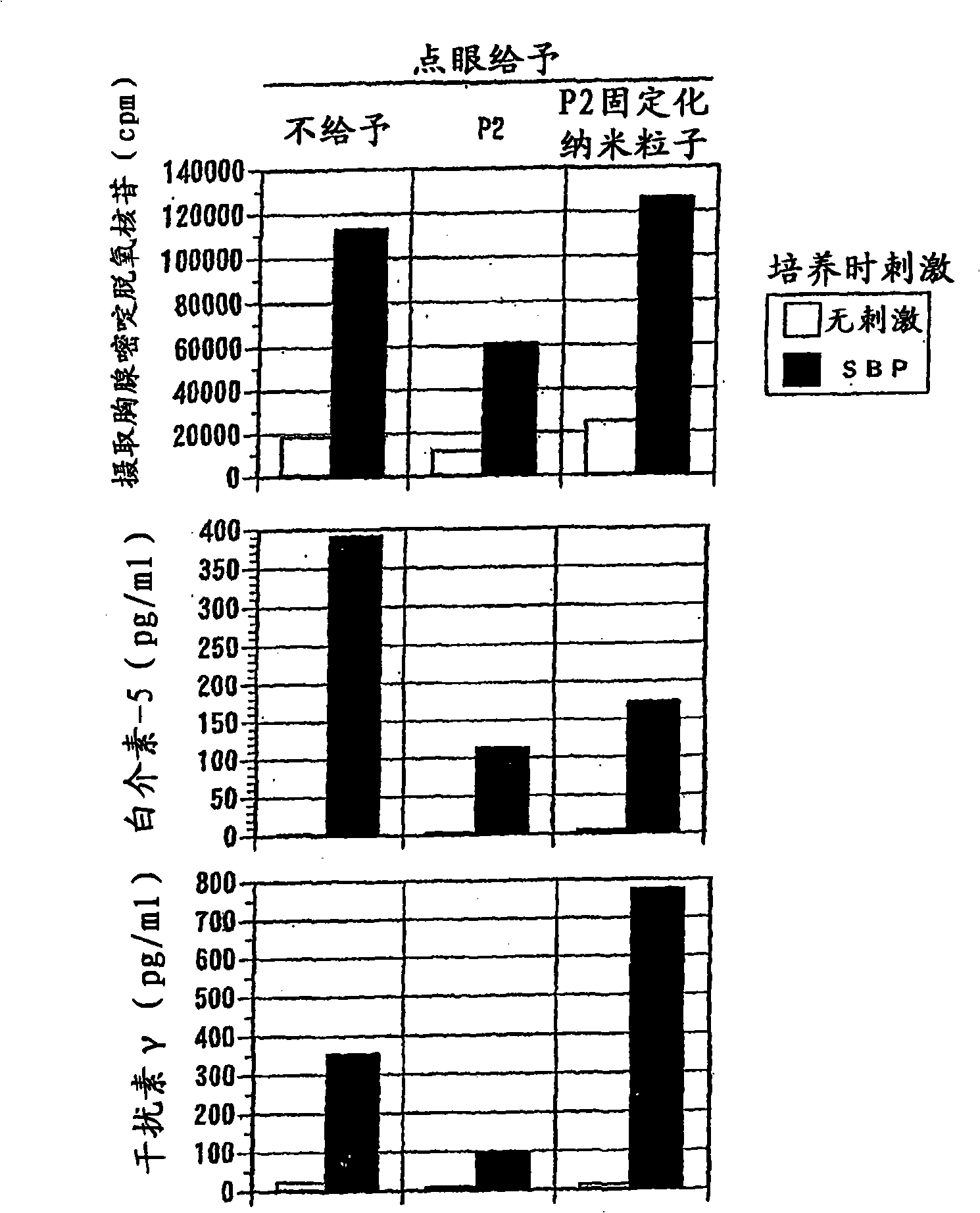Biodegradable nanoparticle having T-cell recognizable epitope peptide immobilized thereon or encapsulated therein
A biodegradable nanoparticle technology, applied in the field of immunotherapy preparations, can solve the problems of low peptide permeability, no report on the use of biodegradable nanoparticles, and problems with oral administration
- Summary
- Abstract
- Description
- Claims
- Application Information
AI Technical Summary
Problems solved by technology
Method used
Image
Examples
Embodiment 1
[0082] (1) Production of PEGylated mouse fir pollen T cell recognition antigen epitope peptide
[0083] As the T cell recognition antigen epitope peptide of Cryj1 BALB / c mouse, select P1:277-290; KQVTIRIGCKTSSS (hereinafter referred to as P1), as the T cell recognition antigen epitope peptide of Cryj2 BALB / c mouse , select P2: 246-259; RAEVSYVHVNGAKF (hereinafter referred to as P2). The PEG (polyethylene glycol) synthesis of the peptide relies on Toray Research Center Co. Ltd., and synthesizes the PEG (polyethylene glycol)-recognized epitope peptide of mouse cedar pollen T cells through the Fmoc solid-phase synthesis method .
[0084] (2) Synthesis of biodegradable nanoparticles immobilized with mouse cedar pollen T cell recognition antigen epitope peptide
[0085] 607 mg (4.7 unit mmol) of poly(γ-glutamic acid) (γ-PGA, molecular weight 300,000) was dissolved in 100 ml of 54 mM aqueous sodium bicarbonate solution (pH 8.5). Then add 1-ethyl-3-(3-dimethylaminopropyl) carbodii...
Embodiment 2
[0087] Immunity-inducing ability of biodegradable nanoparticles immobilized with epitope peptides recognized by mouse fir pollen T cells
[0088] Biodegradable nanoparticles immobilized with Cryj1 or Cryj2 T cell-recognized epitope peptides (P1, P2) (equivalent to 20 μg of peptide) or 100 μl of suspension of nanoparticles without immobilized peptide (50 μl per foot). On the 11th day, the local lymph nodes were excised, and the lymph node cells were recovered and suspended in RPMI1640 medium + 10% fetal calf serum (FCS). In addition, pooled cells from two mice were used for each group. Cells were divided into 5×10 per well 5 Each was seeded in a 96-well plate, and then added P1 or P2 at a final concentration of 20 μg / ml as an antigen stimulation, or 10 μg / ml of cedar pollen crudely purified antigen (Sugi Basic Protein, SBP, Asahi Food and HealthCare Co., Ltd.) . 48 hours after the start of the culture, half the amount of the culture solution was mixed with [ 3 H] Fresh med...
Embodiment 3
[0092] Immunomodulatory effects of biodegradable nanoparticles immobilized with epitope peptides recognized by mouse fir pollen T cells
[0093] (1) Induction of Th1 cytokine immunity by subcutaneous administration
[0094] BALB / c mice (male, 10 weeks old) were subcutaneously injected with 100 μl of a suspension of biodegradable nanoparticles (equivalent to 50 μg of the peptide) of the Cryj1-immobilized T cell recognition epitope peptide (P1) on both paws ( 50 μl per foot). On the 16th day, 5 μg of crude purified antigen SBP from cedar pollen suspended in Freund's incomplete adjuvant was injected into the right paw to induce an immune response. On the 5th day after injection, local lymph node cells were recovered, seeded into 96-well plates by the same method as in Example 2, and then stimulated with crudely purified antigen SBP from cedar pollen at a final concentration of 10 μg / ml. Cell proliferation was measured using the method described in Example 2. For measurement of...
PUM
 Login to View More
Login to View More Abstract
Description
Claims
Application Information
 Login to View More
Login to View More - R&D
- Intellectual Property
- Life Sciences
- Materials
- Tech Scout
- Unparalleled Data Quality
- Higher Quality Content
- 60% Fewer Hallucinations
Browse by: Latest US Patents, China's latest patents, Technical Efficacy Thesaurus, Application Domain, Technology Topic, Popular Technical Reports.
© 2025 PatSnap. All rights reserved.Legal|Privacy policy|Modern Slavery Act Transparency Statement|Sitemap|About US| Contact US: help@patsnap.com



